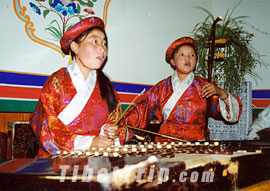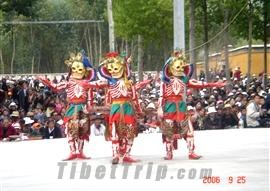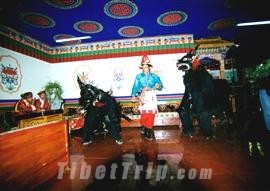 Drum Dance is a most splendid kind of dance for audiences to enjoy. The most impressive among these is the Large Drum Dance, which is also called Choshio and played in the Ongkor or Harvest Festival. It is directed by an old man who wears a blue mask and a colorful Tibetan gown, he shoulders a copper bell and a sword and holds an immortal staff wrapped in a white Khatag. The dancers are also colorfully dressed in a cape and long boots. Each has a large drum with a 60 cm. (2 ft.) diameter that is painted with colorful patterns hung from their shoulders and they use a 'U'-shaped drum stick to beat it. They dance rhythmically to the beat of drums while changing their line form.
Drum Dance is a most splendid kind of dance for audiences to enjoy. The most impressive among these is the Large Drum Dance, which is also called Choshio and played in the Ongkor or Harvest Festival. It is directed by an old man who wears a blue mask and a colorful Tibetan gown, he shoulders a copper bell and a sword and holds an immortal staff wrapped in a white Khatag. The dancers are also colorfully dressed in a cape and long boots. Each has a large drum with a 60 cm. (2 ft.) diameter that is painted with colorful patterns hung from their shoulders and they use a 'U'-shaped drum stick to beat it. They dance rhythmically to the beat of drums while changing their line form.

 Repa is a kind of comprehensive performance that integrates a bell and drum dance, many operas, folk songs and dances together. It is said to have been created by a Tibetan saint Milerepa and is popular in Chamdo, Nyingchi and other Tibetan inhabited Regions of Sichuan and Yunnan Provinces. The performers, also called 'Repa', are mainly wandering actors.
Repa is a kind of comprehensive performance that integrates a bell and drum dance, many operas, folk songs and dances together. It is said to have been created by a Tibetan saint Milerepa and is popular in Chamdo, Nyingchi and other Tibetan inhabited Regions of Sichuan and Yunnan Provinces. The performers, also called 'Repa', are mainly wandering actors.
The famous Bell and Drum dance is the backbone of Repa, which also involves many wonderful technical movements. The performance starts with propitious and showy words, followed by a prelude by men ringing bells and women beating drums while dancing elegantly to extend a circular space. Then the technical performances begin. First women will perform drum-beatings employing various technical and graceful movements. After that with the accompanied rhythms of drum-beating by women, men step on the stage and perform all kinds of technical acrobatics by contorting their flexible bodies. This unique kind of dance has won the acclaim of audiences from home and abroad. The popular saying of 'Dance Repa by gold bells and silver drums' are widespread in Tibet and the dance Repa on the Grassland had won a bronze medal in the international dancing competition.
 Changmo Dance
Changmo Dance
Known as Sorcerer's Dance and the most important religious dance of the temples. It is performed in all the lamasery monasteries across China on the anniversary of the birth of Sakyamuni, the Tibetan New Year and other important religious festivals. In the main it includes animal mines and dharma weapon dances. Unlike the folk dances, it has no songs and is sublime and awesome all through.

The dance commences with a thunderous and sublime concert of various musical instruments such as the Suona horn (A double reed wind instrument with a flaring metal bell), Bo (A flat plate of metal struck with a mallet), drum, long trumpet and pipes. Monks wearing masks play the parts of the Buddhist teachers and they will appear in order according to their status as immortals. These 'immortals' will walk around the stage while accepting the worship of their followers.
Following this are the various brilliant religious dances, like 'Dance of Vajras', 'Dance of Skeletons', 'Dance of Immortal Cranes' and 'Come-uppance'. Various motifs, either for showing the superior power of deities, the joy of small goblins or the preaching for merits and the teachings of sutras are implied. Among these, the lively and vibrant Dance of Skeletons and Dance of Immortal Deer are the most popular. Other performances like wrestling are included to entertain the audiences.
Finally is the interesting 'ghost-exorcism' performance. Here the 'immortals' will cause all ranks of devils to become concentrated in the effigy of their leader Dorma, which is made of Tsamba and yak butter. Dorma will be then taken to an open space near the temple escorted by the 'immortals' and Tibetans. The vicious devil will then be burnt over a wood fire, symbolizing the driving away of all wickedness.

 Opera Dance
Opera Dance
During the brilliant Tibetan Opera, a display of dancing usually follows each operatic performance. There are generally three kinds of dances here. One simulates various activities such as 'riding', 'shooting', 'boating', 'worshipping' and others; another is a direct import from folk dances; and the third is the fixed systematic movements of opera itself. Yak Dance is a very splendid form of dance involved in the Tibetan Opera.
 Royal Dances
Royal Dances
Nangma was historically a famous dance specifically for the palace and aristocratic families. It had adopted some essences from the music of the Chinese hinterland and dance from the regions south of the Yangtze River. The performance has both slow and rapid parts and has been developed into an excellent stage event.
Gar, also called Joyful Dance for Clouds is another kind of royal dance performed by who are called 'Garpa' (the boys from Gar, Ngari). The hierarchy used it to dispel evil and for blessing and praising the political and religious affairs. The dance itself benefits greatly from the accompanying musical instruments, postures and costumes from the inner land and the historically well-known 'west regions' (centered on Xinjiang Province) of China.
![]() Page 1, 2
Page 1, 2








